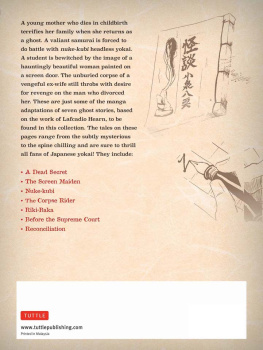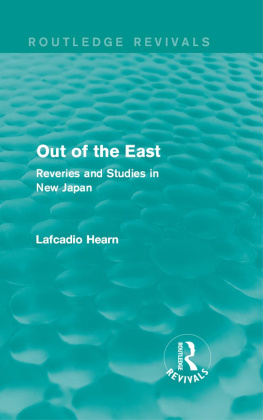Lafcadio Hearn - Glimpses of an Unfamilar Japan, Second Series
Here you can read online Lafcadio Hearn - Glimpses of an Unfamilar Japan, Second Series full text of the book (entire story) in english for free. Download pdf and epub, get meaning, cover and reviews about this ebook. year: 2014, publisher: Duke Classics, genre: Detective and thriller. Description of the work, (preface) as well as reviews are available. Best literature library LitArk.com created for fans of good reading and offers a wide selection of genres:
Romance novel
Science fiction
Adventure
Detective
Science
History
Home and family
Prose
Art
Politics
Computer
Non-fiction
Religion
Business
Children
Humor
Choose a favorite category and find really read worthwhile books. Enjoy immersion in the world of imagination, feel the emotions of the characters or learn something new for yourself, make an fascinating discovery.
- Book:Glimpses of an Unfamilar Japan, Second Series
- Author:
- Publisher:Duke Classics
- Genre:
- Year:2014
- Rating:4 / 5
- Favourites:Add to favourites
- Your mark:
- 80
- 1
- 2
- 3
- 4
- 5
Glimpses of an Unfamilar Japan, Second Series: summary, description and annotation
We offer to read an annotation, description, summary or preface (depends on what the author of the book "Glimpses of an Unfamilar Japan, Second Series" wrote himself). If you haven't found the necessary information about the book — write in the comments, we will try to find it.
In the second volume of Lafcadio Hearns essays on the culture of nineteenth-century Japan, readers are given an firsthand look inside a society that was long cloaked by secrecy and a suspicion of outsiders. These closely observed anecdotes and vignettes will engage fans of top-notch travel writing.
Glimpses of an Unfamilar Japan, Second Series — read online for free the complete book (whole text) full work
Below is the text of the book, divided by pages. System saving the place of the last page read, allows you to conveniently read the book "Glimpses of an Unfamilar Japan, Second Series" online for free, without having to search again every time where you left off. Put a bookmark, and you can go to the page where you finished reading at any time.
Font size:
Interval:
Bookmark:

First published in 1894
ISBN 978-1-62013-696-6
Duke Classics
2014 Duke Classics and its licensors. All rights reserved.
While every effort has been used to ensure the accuracy and reliability of the information contained in this edition, Duke Classics does not assume liability or responsibility for any errors or omissions in this book. Duke Classics does not accept responsibility for loss suffered as a result of reliance upon the accuracy or currency of information contained in this book.
MY little two-story house by the Ohashigawa, although dainty as a bird-cage, proved much too small for comfort at the approach of the hotseasonthe rooms being scarcely higher than steamship cabins, and sonarrow that an ordinary mosquito-net could not be suspended in them. Iwas sorry to lose the beautiful lake view, but I found it necessary toremove to the northern quarter of the city, into a very quiet Streetbehind the mouldering castle. My new home is a katchiu-yashiki, theancient residence of some samurai of high rank. It is shut off from thestreet, or rather roadway, skirting the castle moat by a long, high wallcoped with tiles. One ascends to the gateway, which is almost as largeas that of a temple court, by a low broad flight of stone steps; andprojecting from the wall, to the right of the gate, is a look-outwindow, heavily barred, like a big wooden cage. Thence, in feudal days,armed retainers kept keen watch on all who passed byinvisible watch,for the bars are set so closely that a face behind them cannot be seenfrom the roadway. Inside the gate the approach to the dwelling is alsowalled in on both sides, so that the visitor, unless privileged, couldsee before him only the house entrance, always closed with white shoji.Like all samurai homes, the residence itself is but one story high, butthere are fourteen rooms within, and these are lofty, spacious, andbeautiful. There is, alas, no lake view nor any charming prospect. Partof the O-Shiroyama, with the castle on its summit, half concealed by apark of pines, may be seen above the coping of the front wall, but onlya part; and scarcely a hundred yards behind the house rise denselywooded heights, cutting off not only the horizon, but a large slice ofthe sky as well. For this immurement, however, there exists faircompensation in the shape of a very pretty garden, or rather a series ofgarden spaces, which surround the dwelling on three sides. Broadverandas overlook these, and from a certain veranda angle I can enjoythe sight of two gardens at once. Screens of bamboos and woven rushes,with wide gateless openings in their midst, mark the boundaries of thethree divisions of the pleasure-grounds. But these structures are notintended to serve as true fences; they are ornamental, and only indicatewhere one style of landscape gardening ends and another begins.
Now a few words upon Japanese gardens in general.
After having learnedmerely by seeing, for the practical knowledge ofthe art requires years of study and experience, besides a natural,instinctive sense of beautysomething about the Japanese manner ofarranging flowers, one can thereafter consider European ideas of floraldecoration only as vulgarities. This observation is not the result ofany hasty enthusiasm, but a conviction settled by long residence in theinterior. I have come to understand the unspeakable loveliness of asolitary spray of blossoms arranged as only a Japanese expert knows howto arrange itnot by simply poking the spray into a vase, but byperhaps one whole hour's labour of trimming and posing and daintiestmanipulationand therefore I cannot think now of what we Occidentalscall a 'bouquet' as anything but a vulgar murdering of flowers, anoutrage upon the colour-sense, a brutality, an abomination. Somewhat inthe same way, and for similar reasons, after having learned what an oldJapanese garden is, I can remember our costliest gardens at home only asignorant displays of what wealth can accomplish in the creation ofincongruities that violate nature.
Now a Japanese garden is not a flower garden; neither is it made for thepurpose of cultivating plants. In nine cases out of ten there is nothingin it resembling a flower-bed. Some gardens may contain scarcely a sprigof green; some have nothing green at all, and consist entirely of rocksand pebbles and sand, although these are exceptional. As a rule, aJapanese garden is a landscape garden, yet its existence does not dependupon any fixed allowances of space. It may cover one acre or many acres.It may also be only ten feet square. It may, in extreme cases, be muchless; for a certain kind of Japanese garden can be contrived smallenough to put in a tokonoma. Such a garden, in a vessel no larger than afruit-dish, is called koniwa or toko-niwa, and may occasionally be seenin the tokonoma of humble little dwellings so closely squeezed betweenother structures as to possess no ground in which to cultivate anoutdoor garden. (I say 'an outdoor garden,' because there are indoorgardens, both upstairs and downstairs, in some large Japanese houses.)The toko-niwa is usually made in some curious bowl, or shallow carvedbox or quaintly shaped vessel impossible to describe by any Englishword. Therein are created minuscule hills with minuscule houses uponthem, and microscopic ponds and rivulets spanned by tiny humped bridges;and queer wee plants do duty for trees, and curiously formed pebblesstand for rocks, and there are tiny toro perhaps a tiny torii as wellin short, a charming and living model of a Japanese landscape.
Another fact of prime importance to remember is that, in order tocomprehend the beauty of a Japanese garden, it is necessary tounderstandor at least to learn to understandthe beauty of stones.Not of stones quarried by the hand of man, but of stones shaped bynature only. Until you can feel, and keenly feel, that stones havecharacter, that stones have tones and values, the whole artistic meaningof a Japanese garden cannot be revealed to you. In the foreigner,however aesthetic he may be, this feeling needs to be cultivated bystudy. It is inborn in the Japanese; the soul of the race comprehendsNature infinitely better than we do, at least in her visible forms. Butalthough, being an Occidental, the true sense of the beauty of stonescan be reached by you only through long familiarity with the Japaneseuse and choice of them, the characters of the lessons to be acquiredexist everywhere about you, if your life be in the interior. You cannotwalk through a street without observing tasks and problems in theaesthetics of stones for you to master. At the approaches to temples, bythe side of roads, before holy groves, and in all parks and pleasure-grounds, as well as in all cemeteries, you will notice large, irregular,flat slabs of natural rockmostly from the river-beds and water-wornsculptured with ideographs, but unhewn. These have been set up as votivetablets, as commemorative monuments, as tombstones, and are much morecostly than the ordinary cut-stone columns and haka chiselled with thefigures of divinities in relief. Again, you will see before most of theshrines, nay, even in the grounds of nearly all large homesteads, greatirregular blocks of granite or other hard rock, worn by the action oftorrents, and converted into water-basins (chodzubachi) by cutting acircular hollow in the top. Such are but common examples of theutilisation of stones even in the poorest villages; and if you have anynatural artistic sentiment, you cannot fail to discover, sooner orlater, how much more beautiful are these natural forms than any shapesfrom the hand of the stone-cutter. It is probable, too, that you willbecome so habituated at last to the sight of inscriptions cut upon rocksurfaces, especially if you travel much through the country, that youwill often find yourself involuntarily looking for texts or otherchisellings where there are none, and could not possibly be, as ifideographs belonged by natural law to rock formation. And stones willbegin, perhaps, to assume for you a certain individual or physiognomicalaspectto suggest moods and sensations, as they do to the Japanese.Indeed, Japan is particularly a land of suggestive shapes in stone, ashigh volcanic lands are apt to be; and such shapes doubtless addressedthemselves to the imagination of the race at a time long prior to thedate of that archaic text which tells of demons in Izumo 'who maderocks, and the roots of trees, and leaves, and the foam of the greenwaters to speak.
Font size:
Interval:
Bookmark:
Similar books «Glimpses of an Unfamilar Japan, Second Series»
Look at similar books to Glimpses of an Unfamilar Japan, Second Series. We have selected literature similar in name and meaning in the hope of providing readers with more options to find new, interesting, not yet read works.
Discussion, reviews of the book Glimpses of an Unfamilar Japan, Second Series and just readers' own opinions. Leave your comments, write what you think about the work, its meaning or the main characters. Specify what exactly you liked and what you didn't like, and why you think so.









